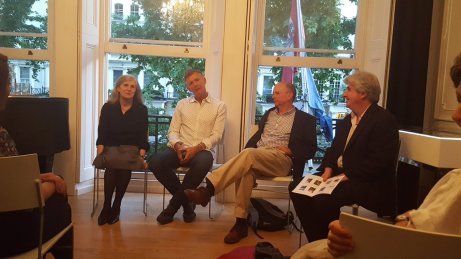On 14 June 2017, Lund Humphries hosted a discussion on the comparative social housing traditions of London and Vienna, at the Austrian Cultural Forum in London as part of the London Festival of Architecture.
Liane Lefaivre, Professor and Chair of Architectural History and Theory at the University of Applied Arts in Vienna Austria, and author of the newly published book Rebel Modernists: Viennese Architecture Since Otto Wagner, led with a presentation of the successful social housing tradition of Vienna. Professor Mark Swenarton of Liverpool University, a leading expert on Camden’s golden age of social housing, gave a talk about the innovative solutions of Neave Brown, the architect of the much-celebrated Alexandra Road development in North London. London-based architect Peter Barber, who is also currently lecturer and design tutor at the University of Westminster, shared his philosophy of building high quality social housing and presented award-winning examples of his practice’s work. A round table discussion between the three speakers followed, chaired by Professor Murray Fraser of the Bartlett School UCL.

Here below we share a few notes we took away from this very interesting evening.
Liane’s key points:
- Good social housing is good for the economy!
- from the late 1970s, the Austrian Social Democratic government, and in particular, Vienna’s city council, have looked back to the past success of Red Vienna’s Gemeindebauen, massive social housing projects, which were conceived by former banker and economist Hugo Breitner who used them as the driver to spend the city’s way out of the depression of the 1920s.
- By stimulating the economy in such a way and also, in providing affordable homes, enabling its citizens to have stability and disposable income, he avoided the book-bust economic cycle more commonly found in Western Europe and North America.
- The Viennese have looked back to this proven economic and social success and continued to invest heavily in social housing throughout the past 30 years. C.£ 600 million pounds’ budget on social housing last year, even when the 2007 ‘bad banks’ crisis has caused a dent in the country’s economy.
- Housing – both large-scale new building programmes and the regeneration of run-down and disused inner cities blocks for social housing – have attracted the leading Austrian architects and, despite having a wide range of designs and styles, are consistently constructed using quality materials and detailing. Individual flats are customised through the architects talking to and collaborating with the future tenants.
- This affordable social housing includes communal facilities such as swimming pools and spas, rooftop gardens, subsidised leisure restaurants and childcare facilities, as well as focusing on integrating citizens which in other places might be in danger of social exclusion, such as the elderly, the disabled, ethnic minorities and refugees. Some popular new blocks are exclusively for female-only tenants.
- The result is that 60% of Vienna’s population now live in social housing and the city is constantly at or near the top of the table for ‘most liveable city’ and for citizen’s satisfaction surveys
- The Austrians are not only able to afford this level of subsidised social housing, but Liane argues that they are a rich country because of the subsidised social housing programme acting as a stabilising influence on the country’s economy. It has all sorts of other social benefits too.
- A few images from Liane’s book are featured here on our blog.
Mark’s key points:
- Leading architects were in Camden in the 1960s and 1970s given the time and resources by a forward-looking city council to develop a hugely influential and successful new type of high density, low-rise housing. (A good illustrated article on Neave Brown’s Alexandra Road Housing can be found on the blog municipal dreams.)
- By removing large, under-used spaces between buildings and through intelligent, creative and careful planning, they allowed a high density in structures which were at most 4 stories high, more usually between 2 and 3 stories and where every home had direct access to the street. The street, connected up to public spaces, is central to the planning of these new schemes and gives them their life and community spirit.
- The support of a council and visionary thinking attracted the most talented of architects working in London at the time and enabled a golden age, allowing this new form of housing to develop – this because the leading new model for housing across the Western world.
- There were problems caused by elections and changing control of the council but the support given them to the programme is almost inconceivable today
Peter’s key points:
- How many families made homeless every day?
- While he’s clearly working in a context which does not have anywhere near the same political or economic support of contemporary Vienna or the 1960s welfare state, he nevertheless has found still visionary council clients who have supported some very elegant, award-winning social housing schemes in England.
- Deeply influenced by Neave Brown and the other Camden architects, he has successfully created contemporary low-rise, high density housing projects, including a beautiful contemporary take on the traditional alms houses for homeless men in Camden (see the Holmes Road project here).
- Private rents need capping, the right-to-buy schemes needs to be ended and many more council houses need to be built
- Housing crisis – where to build – Peter’s proposal is for a 100 mile city – a ring of high density housing that would circle London on the fringes of suburbia and include a transport network.
We highly recommend the inspirational case studies in Liane Lefaivre’s Rebel Modernists: Viennese Architecture Since Otto Wagner, available now from our website and all good shops and a visit to some of Peter Barber’s award-winning projects.
And we look forward to continuing the discussion when Mark Swenarton’s book Cook’s Camden: The Making of Modern Social Housing is published in October 2017.